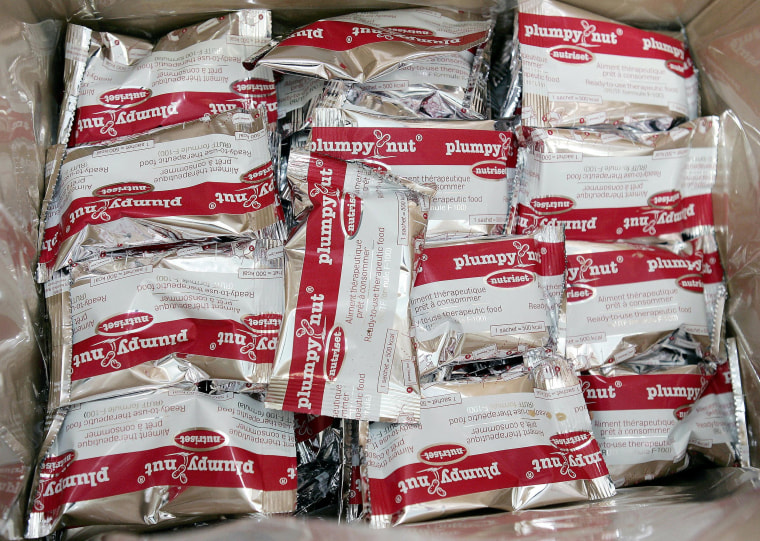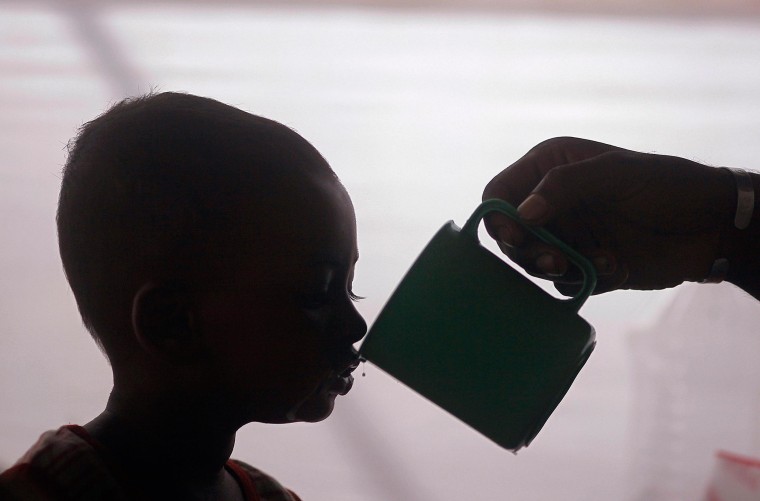A new study may help explain why some children with malnutrition never seem to get better, even when they are finally fed. It has to do with the population of germs that live in the intestines and help digest food, researchers said Wednesday.
The findings suggest it's possible that food alone might not be enough to help kids recover from malnutrition. They may need a bacterial boost, also.
It’s become common knowledge that everyone carries a microbiome — a population of microbes such as bacteria and yeast that affect all sorts of functions, from absorbing food to immune response and even, possibly, mental illness.
Babies inherit their gut and skin germs from their mothers, other caregivers and probably from the food they eat. Researchers are trying to figure out what the elements of an optimal microbiome are. People with imbalances may be more prone to obesity, but an imbalance may also hurt a child’s ability to absorb nutrients from food.
Dr. Jeffrey Gordon and his student Sathish Subramanian asked whether this may help explain why some children remain stunted and have learning difficulties even after they’ve been treated for malnutrition.
“Although therapeutic food-based interventions have resulted in a significant decline in deaths from malnutrition, many children never fully recover,” said Subramanian.
"These children, although they gained weight, remained severely stunted and severely underweight."
“These children, as they continue in their lives, are not able to achieve their full human potential for reasons that are obscure,” Gordon told NBC news. “Our thought was that perhaps the gut microbial community was a factor.”
They focused on children in the slums of Dhaka, Bangladesh. “They come from an urban slum where some children are severely malnourished, some moderately and some are healthy," Gordon said.
This can happen even among siblings in the same family, so something other than simply what they are eating may be involved, Gordon reasoned.
They did a series of tests on kids, sampling healthy children first of all to see what their gut bacteria looked like, by taking fecal samples. They got a good picture of how a healthy child’s microbiome grows and matures from infancy to age 2.
“Using this microbial signature of normal gut microbial community maturation, we evaluated the gut microbial communities of 64 severely malnourished children before, during and after they received standard food-based interventions,” Gordon said.
The 64 babies, aged 6 months to 20 months, were randomly assigned to get one of two different special meals for malnourished kids — Plumpy’Nut, a peanut-based, nutrient-enriched food that is popular for treating severe malnutrition worldwide, or Khichuri-Halwa, a rice-and-lentil based enriched food produced in Bangladesh.

Most children were fed for about two weeks, until they had reached certain weights. The researchers watched them and took fecal samples monthly for four months.
Most children did not thrive on either regime, Gordon’s team reports in the journal Nature. “These children, although they gained weight, remained severely stunted and severely underweight, and their health was not fully restored,” Gordon said.
Tests of the gut microbes showed they malnourished kids continued to look different from the healthy kids. “These children never attained normal maturation of their microbial community,” Gordon said.
Much more study is needed before doctors can say exactly what is going on, Gordon says. It’s possible the children weren’t fed supplementary meals for long enough. It’s possible different foods would do a better job of helping the babies grow a healthy gut microbiome. It’s also possible that probiotics might help.
“We can’t just think about food as repair item."
What’s clear in Bangladesh and in other countries is simply feeding children until they reach a certain weight may not be enough.
“We can’t just think about food as repair item,” Gordon said.
He says his team’s work is a start on getting a map for what a healthy microbiome should look like. Next steps would be different experimental approaches to seeing what helps the “good” bacteria take over and thrive inside a child’s digestive system.
“We want to know whether and how this immaturity is linked to the long-term consequences of malnutrition such as stunted growth, impaired immunity and neurodevelopmental abnormalities,” Gordon said.
The World Health Organization estimates that 20 million children worldwide are severely malnourished. And 30 million children are moderately malnourished in southern India and Bangladesh. Overall, more than 40 percent of Bangladeshi children under age 5 have stunted growth.
“Treatment of malnutrition is challenging in a developing country like Bangladesh, where more than half a million children under 5 years of age suffer from severe acute malnutrition and close to 2 million from moderate acute malnutrition,” said Tahmeed Ahmed, who heads the Nutrition Program at the International Centre for Diarrheal Disease Research in Bangladesh and who worked with the study team.
“This research has contributed immensely to what we know about the mechanisms operating in acute malnutrition. I believe it will open up new vistas for simplifying treatment of this dreadful condition that affects millions of children globally.”
